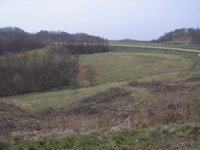In an effort to address concerns from the
U.S. Supreme Court regarding its waterways jurisdiction, the
U.S. Army Corps of Engineers, along with the
US Environmental Protection Agency, released a new set of guidelines on June 5, 2007 stating it will continue to oversee rivers and streams – including ephemeral streams – based on a series of tests developers must pass.
In June 2006, the Supreme Court ruled that the Corps’ definition of its jurisdictional waters “intruded into issues surrounding land use, which is an area traditionally under state authority.” Authorizing federal action in that area “stretched the limits of Congress’s commerce power” and was therefore flawed.
To see a synopsis of the court case that led to the debate and resulting guidelines,
click here.
In combination with the “
Significant Nexus Test” recommended by the Court, the new guidelines state that jurisdictional waters are divided into two categories and must pass both the
Scalia Plurality and Kennedy Concurrence tests – named after two of the 9 U.S. Supreme Court justices who opposed the Corps’ decision to halt two development projects in violation of the
Clean Water Act.
To see the new guidelines, visit the
US EPA website.
These issues largely impact land development in the Mid-Atlantic region – especially West Virginia – because many streams impacted are streams that only flow during times of precipitation. With the new guidelines, all headwater streams will be analyzed on a case-by-case basis that will determine whether the Corps has jurisdiction.
The coal industry worries how this new set of guidelines will impact what it considers the best available technology – the sediment pond – to reduce the amount of sediment or soil material that flows downstream during times of operation. In fact, according to
The State Journal,
West Virginia Coal Association spokesperson Jason Bostic thinks it’s a matter of time before the regulations affect other areas of the land development industry as well.
Change is as old as the earth. Certainly, we want to preserve and be respectful of the environment. But in order to prevent undo delays and possible prohibitions that these new guidelines may cause land developers, we should carefully examine the balance between progress and preserving/conserving our environment.
The land development industry is nearly at the point where any individual disturbance due to development is going to require a permit.
“Cost and time associated with permitting under the new guidelines may make it prohibitive for the entrepreneur to develop his or her property,” said Bill Hilborn of
Kanawha Stone Company – a heavy highway and site development construction company located in Poca, W.Va. “We are looking at a six month cycle for permitting under these guidelines with a high preparation cost. That doesn’t count the cost of mitigation.”
Permitting through the Corps has taken considerable amounts of time in the past and will only continue to get worse under its new guidelines, which will require the case-by-case assessment of jurisdictional rights. The Corps has a limited staff and the workload is going to increase.
Can the land development industry handle the potential threats these guidelines may cause? Let us know your thoughts.
